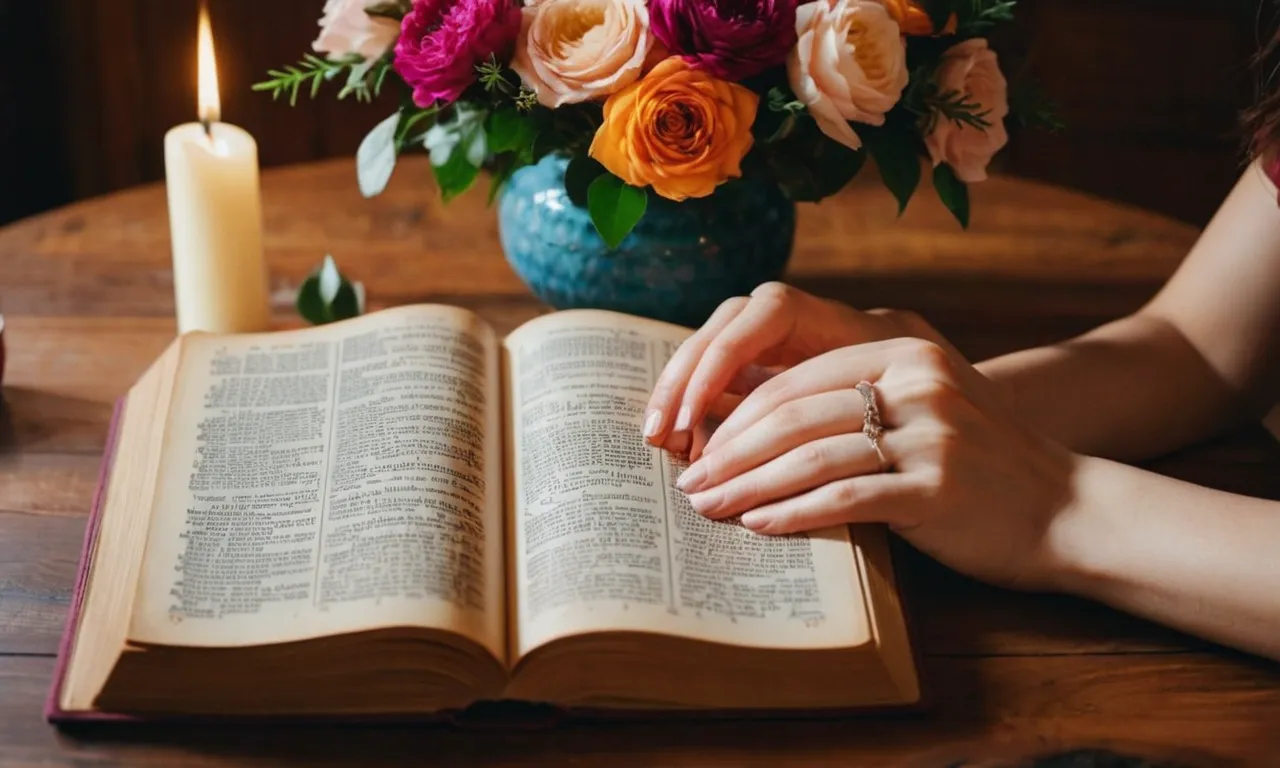How To Build An Altar For God
Worshiping God is an important part of many people’s faith. Building an altar in your home is one way to create a sacred space for daily devotion and prayer. In this comprehensive guide, we will walk through everything you need to know to design and construct a beautiful altar for God.
If you’re short on time, here’s a quick answer to your question: Start by choosing a location, then select items with spiritual meaning like candles, religious images, flowers, offerings, and altar cloths to adorn your altar.
Place items intentionally to create an inspiring focal point for prayer and contemplation of the divine.
In this step-by-step tutorial, we will cover choosing an ideal location in your home, gathering altar items and decorations that hold meaning and symbolism, assembling your altar thoughtfully and purposefully, consecrating your altar space, and how to use your altar for offerings, prayer, and meditation.
Choosing an Ideal Location
Consider Accessibility
When selecting a spot for your altar, you’ll want to consider how accessible the location is. Choose somewhere that is easy to get to and convenient for you to visit frequently, like a bedroom, den, or other quiet personal space in your home.
Consider traffic flow if placing it in a high-traffic area, so it doesn’t feel crowded or become an obstacle. The key is finding a spot that allows you to easily incorporate the altar into your daily routine for prayer or meditation.
As the popular saying goes, “out of sight, out of mind,” so optimal accessibility helps ensure you’ll actually use your sacred space.
Look for Natural Light
If possible, position your altar near a window or source of natural light. Sunlight nurtures life and can lend a peaceful, uplifting energy and atmosphere to your altar location. Notice where the light filters into your potential spot at different times of day.
Morning light from the east signifies renewal, while southern exposure brings powerfully energizing and cleansing solar energy as the sun arcs high in the midday sky. If your design allows, consider placing votive candles or small potted plants on your altar to further emphasize the connection between sunlight and living spirit.
Find a Quiet Space
When evaluating altar locations, sound is another key factor along with accessibility and light. Seek out the most quiet, tranquil place possible in your home. Even subtle ambient noises like humming appliances, pedestrian traffic outside a window, or heating and cooling system sounds can undermine the meditative process.
Look for a corner away from disruptive noises, or investigate acoustic panels and curtains if needed to further soundproof your sacred area. Establishing a separate zone of quiet helps cue your mind and body to fully focus once you sit down at your altar.
Gathering Altar Items and Decorations
Candles
Candles are essential on most altars to represent the light of Christ. Traditionally, two large pillar candles are placed on either side of the altar with a central Christ candle between them. Pillar candles can come in a variety of colors to symbolize the season or purpose of the altar.
Try white for purity, purple for Advent or Lent, and red for Pentecost or saints’ feast days. Small votive candles may also be arranged around the altar.
Religious Images or Icons
Crucifixes, images of Christ, the Virgin Mary, saints, or angels are common altarpieces. They help focus our minds on the divine mysteries. Traditional Catholic and Orthodox altars feature elaborate iconography, while Protestant altars may display a simple cross.
Images can be made of wood, stone, metal, mosaic tile, or paint. Try finding one with special meaning for your faith.
Offering Bowls or Plates
Offering dishes allow a place to present our spiritual gifts on the altar. Some ideas are patens for bread, chalices for wine or juice, incense boats, vessels for oils or water, baskets for notes or prayers, plates for fruits/flowers, or bowls for monetary offerings.
Choose materials connected to your tradition like pottery, silver, brass, or wicker.
Flowers and Greenery
Fresh flowers and greenery breathe life into an altar. Try arrangements that reflect the colors and plants of the liturgical season. Some examples are poinsettias for Christmas, lilies for Easter, roses for Marian feasts, sunflowers for St. Francis, lavender for healing, or olive branches for peace.
Keep safety in mind by avoiding poisonous flowers around pets or children.
Altar Cloths
Altar cloths create a clean, decorative surface for sacred items. Options range from ornate brocades with embroidery and goldwork to simple linen or cotton. Look for cloths in liturgical colors or patterns meaningful to your faith. Change the altar cloth to match special days.
Protect fine textiles by layering with a washable cloth underneath.
Incense and Burners
The smoke of incense carries prayers and petitions heavenward. Burners or censers swing on chains to spread the fragrance. Abalone shells hold a glowing charcoal disc and spoonfuls of incense grains or resin. Try traditional frankincense and myrrh or scents like rose, vanilla, pine, or sage.
Note: Avoid overwhelming indoor spaces and check for allergy issues first.
Sacred Texts and Books
The main holy scriptures like the Bible, Quran, Torah, or other wisdom writings bring divine inspiration to an altar. Choose a special edition, study books, or prayer and devotionals to display. Prop open pages to favorite passages. Some traditions write prayers or petitions on small scrolls to offer.
Use book stands, lecterns, or shelves to prominently exhibit sacred texts.
Symbols of Faith
Meaningful religious symbols personalize an altar. Some ideas are crosses, the chi-rho, ichthys, menorah, Star of David, yin-yang, Aum, or lotus. Display special sacramentals like saints’ medals, rosaries, prayer beads, small statues, bells, feathers, shells, stones, horns, antlers, dreamcatchers, arrowheads, healing wands, or animal totems.
Let your spirit guide you.
Bells
The ringing of bells signals prayers, invokes angels or saints, or creates purification. Try displaying bells representing different pitches. Use brass bells or tingsha cymbals from India, ceramic Zen temple bells, or delicate glass bells.
You can ring a bell to start and end prayer times or to punctuate petitions. Allow the lingering tones to shift energy.
Crystals and Stones
Crystals and stones bring ancient earth energy and healing properties to an altar. Clear quartz, rose quartz, amethyst, obsidian, tiger’s eye, turquoise, agate, onyx, and selenite are some top choices. Tumblestones work well. Set larger ones in the four compass directions.
Charge crystals in moonlight or sunlight. Caution: Consult experts before using crystals medicinally.
Assembling and Arranging Your Altar
Choose a Focal Point
Every altar needs a main focal point that draws the eye and focuses attention. This is often an image or statue of a deity, religious figure, or spiritual symbol. When choosing a focal point, select something meaningful that inspires reverence and worship.
Center the focal point on the altar and build outward from it. Focal points don’t have to be large – even a small cross, Buddha statue or menorah can serve as the anchor for your altar.
Layer Decorations Purposefully
The items you place around your focal point add meaning and depth to the altar. Think intentionally about each object and where you position it. For example, items representing earth could go on the lower level, divinity at the top, and symbols of transformation and change in the middle.
Layer colors, textures, shapes and materials in a purposeful way. Allow room between items for visual breathing space.
Add Height with Risers
Adding levels creates a sense of ascent and draws the eye upward. This represents spiritual progression. Place focal points, statues or special objects on risers made of wood, glass or acrylic to give them prominence. Candles and flowers also gain impact when elevated above the altar’s base level.
Include Personal Mementos
Altars feel most meaningful when they include personal touches that represent your spiritual path. Mementos like stones or shells from nature, gifts received, photos of loved ones, or items from important events add a personal energy. They remind you this is your sacred space.
Use Symmetry and Balance
A balanced altar has a centered, grounded feeling.Place focal points and larger objects in the center. Balance the altar by arranging complementary items on either side such as pairs of candles or similar objects in the same position. Using an odd number of items (1, 3, 5, etc.) also creates balance.
Allow Open Space
Don’t clutter the altar or pack it too tightly. Leave open space around focal points and between items. This allows the energy to flow and makes the altar feel tranquil. Airy spaces allow you to focus on each item individually instead of competing visual overload.
Consecrating Your Altar
Perform a Cleansing Ritual
Before setting up your altar, it’s important to spiritually cleanse the space. This can be done by burning sage, ringing bells, or diffusing essential oils like frankincense or myrrh. You’ll want to intone prayers or affirmations as you move through the space to elevate the vibration and invite in positive energy.
When finished, be sure to open windows to allow any stagnant energy to flow out.
Mark the Occasion
Building an altar is a sacred act, so you’ll want to commemorate the occasion. Consider writing the date down in your Book of Shadows or journal. You could also take a before and after photo to capture the process. If others are involved, have them sign something for the altar space.
Finally, say an intention or prayer to bless the altar and set its purpose. By consciously observing this new addition, you amplify its meaning.
Decorate to Celebrate
Now comes the fun part – decorating! As you place items on the altar, infuse each piece with intent. Clear crystals can amplify vibrations, tarot cards connect with inner wisdom, and flowers raise the energy through beauty and fragrance.
Meaningful religious symbols like crosses or Pentacles consecrate the space. You could include statues of deities or sacred texts to align the altar with your faith. Feel free to get creative with fabrics, wreaths, candles and imagery that lift your spirit!
Changing decor according to the seasons or Sabbats keeps things fresh.
Say a Prayer of Dedication
Once your altar items are in place, say a prayer to dedicate it to the divine. This breathes life into the altar and activates its sacred purpose. In the prayer, call upon any religious figures or deities with whom you have connection.
State the goals of your altar – perhaps inviting in peace, love and healing light. You might ask for wisdom, prosperity, protection or guidance from the Divine source. Close with affection and gratitude.
You may also want to recite this dedication prayer regularly to recharge the altar’s high vibration.
Using Your Altar for Prayer and Meditation
Daily Prayer
Set aside time each day to visit your altar and offer up prayers of gratitude and requests for guidance. Many find starting the day in prayer helps set a positive tone. Light a candle on the altar and sit quietly for a few minutes to clear your mind before speaking your prayers aloud or silently.
Keep a prayer journal nearby to write down thoughts and reflections.
Scripture Reading
The altar can be a peaceful spot for reading inspirational scriptures or spiritual texts. Set aside 10-15 minutes to read a few passages slowly and mindfully reflect on their meaning. Highlight passages that resonate and revisit them.
Use commentaries or online resources to deepen your understanding if desired. This regular reading strengthens your faith and connection with the divine.
Meditation
Many use their altar as a focal point for meditation, centering the mind and opening to inner wisdom. Sit comfortably with eyes open or closed, concentrating on the breath while gazing softly at a candle, symbolic image or other meaningful altar object.
When thoughts intrude, gently return focus to the breath and altar. Even 5-10 minutes daily provides health benefits but longer sessions take you deeper.
Leave Offerings
Show appreciation and honor your chosen deities or spiritual beings by leaving small offerings on the altar. Popular offerings include candles, flowers, fruits, sweets, coins, shells or written notes expressing gratitude.
Set the intention that the offering carries your prayers and petitions to be received. Remove food items within a day and drink/disperse any liquids offered to avoid spoiling.
Observe Spiritual Rituals
An altar makes a fitting spot for observing annual rituals, rites of passage, or celebrations aligned with your faith. For example, you may display special holiday symbols, honor a loved one who has passed with candles or photos, or bless important life events like a new home or pregnancy.
Adapt rituals and ceremonies meaningful to you and develop your own spiritual traditions over time.
Find Inspiration
When facing challenges or needing a nudge of inspiration, come sit at your altar. Light some incense, gaze at the images and objects you’ve curated, and open your heart. Notice what feelings, memories or insights surface.
You might pick a tarot or oracle card for guidance or thumb through a book of prayers and affirmations. By making regular spiritual practice part of your life at the altar, you grow your intuition and draw strength from within.
Conclusion
Creating an altar is a meaningful way to carve out sacred space in your home for spiritual reflection and communion with the divine. As you craft your altar, let the process guide you to curate a collection of items that hold deep personal symbolism and inspire you to regularly practice prayer, meditation, and gratitude.
Follow this guide mindfully to choose an optimal location, select decor with intention, aesthetically arrange your altar, consecrate it through ritual, and integrate it into a devotional practice. Your altar will become a cherished, contemplative haven to enrich your connection with God day after day.








